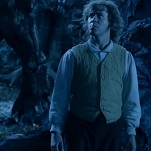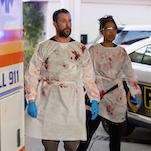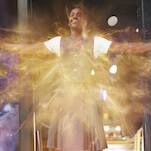Tasked with selling America on a European land war with the fish-mawed, tentacled Mimics, Cruise’s ex-ad-man ships off to London, misbehaves, and gets punished with an assignment to the front lines of a disastrous beachhead assault. Regardless of intention, sci-fi movies tend to fetishize military tech, which makes Edge Of Tomorrow’s Jackets—ugly, cumbersome, mechanized suits worn by the ground forces of its near future—feel refreshing. Their unintuitive controls and shoddy batteries (made to resemble Claymore mines, complete with “Front Toward Enemy” lettering) become a running gag. The attack, dubbed Operation Downfall, is woefully underplanned; ammo is scarce, and the Osprey-style transports end up killing more troops than they land. The resulting battlefield is a surface of rough textures, lumbering machines, and brutalist geometric lines, broken up only by the movement of the Mimics, whose herky-jerky darting resembles sped-up stop-motion.
Barely able to figure out how to turn off the safety on his Jacket, the hapless hero gets killed, and then wakes up back at the forward operating base where he started. Once again, he gets assigned to misfit J Squad, led by Master Sergeant Farell (Bill Paxton, who gets to repeat some of the movie’s best lines); again, they put on Jackets, land on the beaches of northern France, and are massacred by the Mimics; again, he wakes up 24 hours earlier and repeats the cycle. It goes on and on, restarting every time he dies. (Edge Of Tomorrow mines this mechanic for dark humor, including a montage of Cruise getting shot in the head over and over.) In the process, he hones skills, learns humility, and gains an appreciation for the nobodies whose “necessary sacrifice” he had once sold to the American public. He also develops feelings for Rita Vrataski (Emily Blunt), a hard-ass war hero who was once caught in a similar loop, but he can’t act on them, because every time they meet, it’s for the first time.
The role is tailor-made for Cruise, whose reflexes and facial expressions have always suggested rigorous practice, as though he had conditioned himself to look good doing anything from any angle. Even the character’s name, William Cage, sounds artificial—just like Roy Miller, Jack Harper, Ethan Hunt, or Tom Cruise. In the early scenes, Cage’s insincerity is communicated by Cruise’s perfect talk-show smile. Later on, his assertive, athletic body language creates the sense that Cage has already been through a scene several times before, even if the audience hasn’t seen it. (To ensure a consistent momentum, Edge Of Tomorrow begins skipping repetitions later on.)
Edge Of Tomorrow’s main attraction is this near-seamless blend of star, structure, and setup. Its deft pacing, canny design, and sense of humor make it easy to overlook the fact that it mostly glosses over the implications of its time-loop premise. Consistency is a rare virtue for a big-budget tentpole movie; remarkably, the movie’s ending (which diverges from Hiroshi Sakurazaka’s source novel, All You Need Is Kill) manages to preserve a sense of integrity while delivering the requisite audience satisfaction.








































